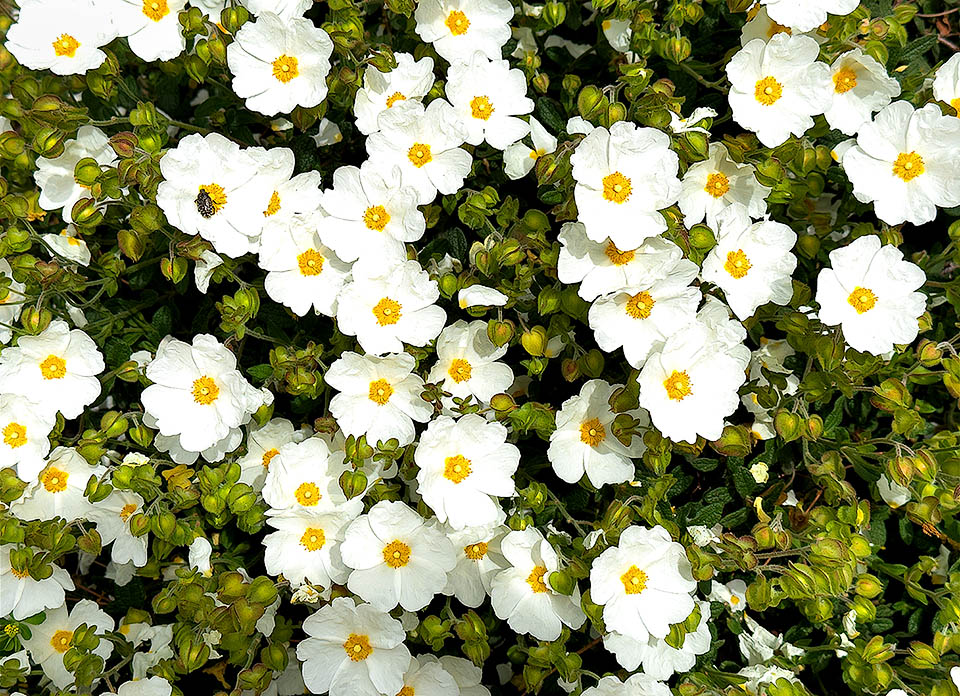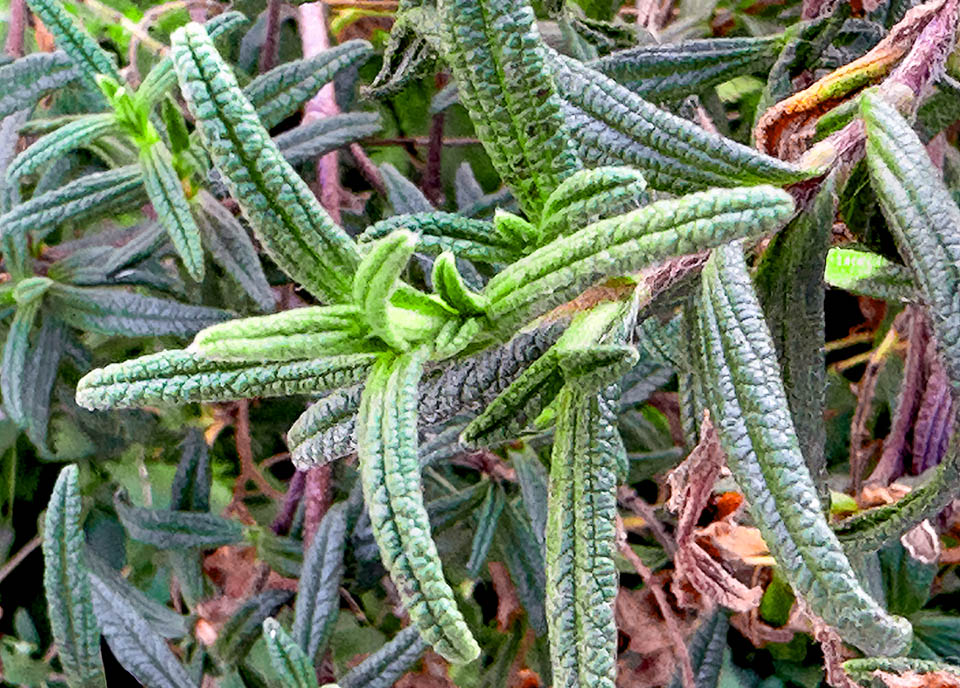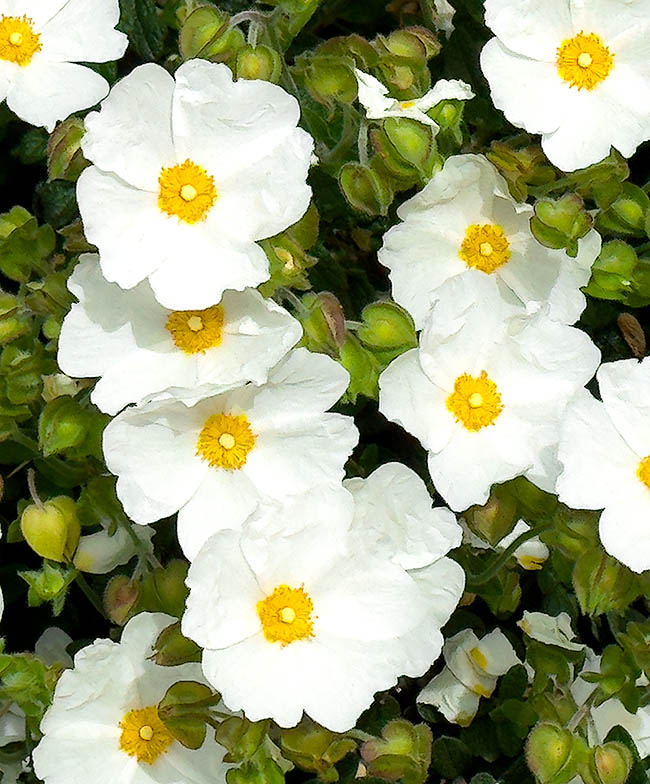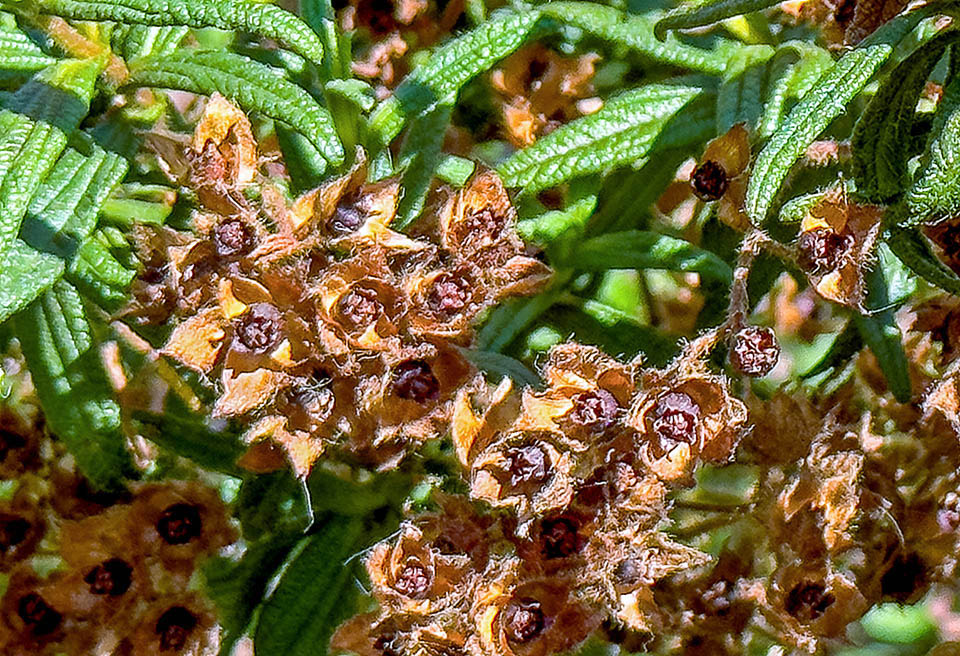Family : Cistaceae

Text © Prof. Paolo Grossoni

English translation by Mario Beltramini

The Montpellier rock-rose (Cistus monspeliensis) is a Mediterranean evergreen shrub, very aromatic, reaching the height of 70-100 cm © Giuseppe Mazza
Cistus monspeliensis L. (1753), family Cistaceae Juss. (1789), genus Cistus L. (1753), owes its specific epithet to the Occitan city of Montpellier home to the first French botanical garden, founded in 1593 by Pierre de Belleval.
Even if lacking any taxonomic validity, in the nursery practice we continue to associate the species of the genus Cistus depending on the colours of the petals and Cistus monspeliensis is included in the category White or Whitish Pink Clade’ (WWPC). This cistus is called cisto di Montpellier, cisto marino, rembrottine in Italian; Montpellier rock-rose, narrow leaved cistus in English; ciste de Montpellier in French; Jaguarzo negra, estepa negra in Spanish; Schmalblättrige Zitrose in German.
Like all Mediterranean cisti also the Montpellier rock-rose is an evergreen shrub, highly aromatic, slender, 70-100 (120) cm tall with very branchy stems; the young ones are initially erect, thin and remarkably viscous due to the numerous very long, then decumbent, glandular hairs; the bark is dark brown.
The leaves, opposite, are simple, sessile and three-nerved; they are sticky to the touch.

It stands out at first sight from Cistus salviifolius, also with white flowers, for the linear lanceolate leaves, viscous at touch, up to 5 cm long © Giuseppe Mazza
The lamina is linear-lanceolate, pointed at the apex and is up to 5 cm long and 1/5 to 1/10 of the length broad; is revolute along the edges and has the upper pagina dark green and wrinkled-reticulated with few hairs whilst the lower one is densely downy. During the summer growth arrest the Montpellier rock-rose enters into rest, loses more or less consistent part of the leaves and those that remain get thicker, more downy and assume an intense brown colour that makes them look burnt.
The flowering occurs in April-May and the flowers are merged in groups of 2-8 (10) in defined inflorescences where the flowers, arranged along the floral axis, mature according to a temporal sequence (scorpioid cyme).
The flowers are inserted on thin peduncles, pubescent and 2-4 cm long; they have an ephemeral corolla of 2-3 cm of diameter formed by 5 petals without margins, white with yellow unguis. The calyx is formed by 5 petals, hairy and unequal being the three outer ones bigger than the inner two. The ovary is superior and is surmounted by one style of minimum size; the androecium is formed by several yellow stamens.
The fruit is a subglobose capsule of relatively reduced size (4 (5) mm of diameter) with dehiscence septicide (the single valves open along their margins). The seeds are angular and reach 1,3-1,5 mm of diameter.

The 2-3 cm flowers are ephemeral but flowers bloom one after the other, united in even 10 elements inflorescences © Giuseppe Mazza
The chromosomal number of the species is the same of all the genus: 2n = 18.
The Montpellier rock-rose is a strictly Mediterranean species growing in the coastal zones penetrating inside only in hilly environments corresponding to the so-called “olive area”.
It. is found in the islands of Macaronesia and of Mediterranean, in the Iberian peninsula, in the Italian one and in the central-northern part of the Balkan one, in southern France and, in the extra-European Mediterranean, in north-western Africa, in the Anatolian peninsula and in the islands of the Aegean Sea.
Heliophilous and xerophilous, it’s an acidophilic species that however may adapt also to more or less arid calcareous substrata because, in these cases, the vegetation is more sparse and is in greater difficulty and therefore is not particularly competitive.
Cistus monspeliensis is a very active pyrophyte that succeeds in colonizing very quickly the soils affected by fire and for this reason is utilized in naturalistic engineering.
The seed coats, airtight and waterproof, prevent the embryo from germinating.
In nature the synergic action of atmospheric agents and of organisms slowly deteriorates the structure of the integuments thus allowing the water and the oxygen to reach the embryonic tissues.
High temperatures like those of the passage of the fire or of a thermal shock of (80) -110 °C allow the immediate germination of the seeds.
It is good practice to leave the plant to grow, intervening, if necessary, only with light prunings because the capacity of sprouting again is rather poor.
It is also employed as a melliferous plant and as an ornamental plant being easily multiplied by seed or by cutting.
The scaling of blooming guarantees a decorative result lasting till the peak of the arid season. At times, due to the similarity in colour and in the size of the flower and in the posture of the plant, Cistus clusii Dunai and Cistus libanotis L. are confused with the Montpellier rock-rose.
The first is a cistus of north-western Africa, of the Iberian Peninsula and the Balearic Islands, and of southern Italy (Puglia and Sicily), the second is limited to south-western Spain and southern Portugal. However, both have strictly linear leaves (they recall those of the rosemary) and the calyx formed by 3 sepals.

The fruit is a 4-5 mm broad capsule with 1,3-1.5 mm seeds. The embryo germinates preferably after a fire because it frees the soil from competitors © Giuseppe Mazza
Cistus monspeliensis has been the subject of several denominations partly invalidated and partly accepted as synonyms and, in this regard, ‘WFO World Flora Online‘ has registered 21 synonyms.
In 2011 was made known a subspecies of this cistus (Cistus monspeliensis subsp. canariensis Rivas Mart., Martin Osorio & Wildpret) but this taxon has not been accepted therefore this name is presently to be considered as a synonym.
Conversely, nursery cultivars of this species are ‘Minor’, with branches, leaves and flowers of reduced size, and ‘Vicar’s Mead’ that has flowers with petals of a pale yellow colour.
Always in the nursery sector there are some agricultural cultivars aggregated in a so-called “densifolius group” because they have densely hairy leaves and, on the branchlet, very close to each other.
On the other hand, the hybrids are more numerous, even with various variants with other species of the genus, like: Cistus inflatus Pourr. ex J.P.Demoly, Cistus ladanifer L., Cistus laurifolius L., Cistus libanotis L., Cistus parviflorus Lam., Cistus populifolius L., Cistus salviifolius L.
→ To appreciate the biodiversity within CISTACEAE family please click here.
